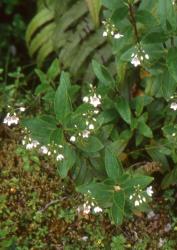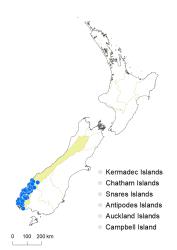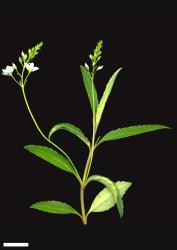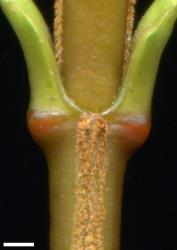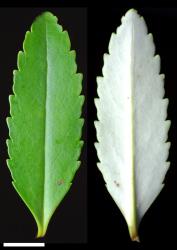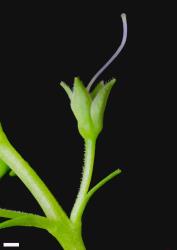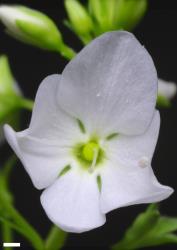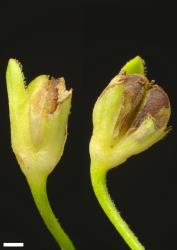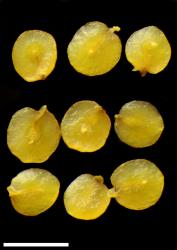- ≡ Hebe catarractae (G.Forst.) A.Wall, Trans. & Proc. New Zealand Inst. 60: 384 (1929)
- ≡ Parahebe catarractae (G.Forst.) W.R.B.Oliv., Rec. Domin. Mus. 1: 230 (1944)
- = Veronica catarractae var. minor Hook.f., Bot. Antarct. Voy. II (Fl. Nov.-Zel.) Part II, 195 (1854)
Sub-shrub to 0.5 m tall. Stems ascending to erect, eglandular-pubescent; hairs bifarious. Leaf bud indistinct; leaves separating while small, opposite-decussate, erecto-patent to spreading; lamina sub-coriaceous, linear to lanceolate or rarely elliptic to oblanceolate, 20–120 mm long, 5–30 mm wide, dull, green above, greenish-white beneath; midrib and lateral veins evident, especially above; surfaces glabrous except for eglandular hairs along midrib above; margin glabrous, serrate; teeth in 5–25 pairs; apex acute; base cuneate; petiole 2–10 mm long. Inflorescence a lateral raceme, 60–250 mm long; flowers distant, 12–40, all bisexual; bracts alternate, linear to narrowly lanceolate, < pedicels; pedicels sub-erect, incurved at fruiting, 9–23 mm long, eglandular- or glandular-hairy in one row or rarely all around. Calyx lobes 4, acute or acuminate, 2–4 mm long, equal, eglandular-ciliate, sometimes mixed eglandular- and glandular-ciliate. Corolla 10–14 mm diameter; tube white and yellow, 1.0–1.5 mm long, < calyx, eglandular-hairy inside; lobes 4, sometimes 5 by division of posterior lobe, white, sub-erect to spreading, unequal, elliptic to orbicular, 5–7 mm long, rounded; nectar guides purplish, sometimes pink or absent. Stamen filaments white, 3–6 mm long; anthers magenta. Style glabrous, 4–5 mm long. Capsules weakly angustiseptate, emarginate, glabrous, 3.5–5.0 mm long, 3.5–5.0 mm at widest point. Seeds 20–50 per locule, ellipsoid to discoid, flattened, smooth, pale brown, 0.8–1.1 mm long.
Veronica catarractae plants are larger than most other speedwell hebes, a group of Veronica characterised by flowers that have short corolla tubes with magenta nectar guides and usually plicate lateral corolla lobes. Among speedwell hebes, plants of V. senex and some forms of V. lanceolata, especially from Taranaki and Coromandel, have similar large leaves, but these differ in having pale green or sometimes pinkish leaf undersides and hairs all around the pedicel rather than in a line. Also, V. senex plants often have short, eglandular hairs on both leaf surfaces.
South Island: Westland (southernmost parts), Fiordland.
River banks, usually rooted in sand and silt in rock crevices, cliffs, landslide debris, lowland to montane. Recorded elevations range from 30 to 1006 m.
Flowers: December–February, sometimes to April; fruits: January to April.
2n = 42 (as n = 21; Garnock-Jones & Langer 1980). Previous counts recorded as Parahebe catarractae have been from plants of V. lanceolata and V. melanocaulon).
Veronica catarractae is classified in V. subg. Pseudoveronica sect. Hebe and informally in the “speedwell hebe” group (Albach & Meudt 2010). It is a member of the speedwell hebe clade, and appears to be sister to V. lyallii based on nuclear and chloroplast DNA sequence data.
Sometimes the lowest inflorescence bracts may be leaf-like (i.e., larger and toothed).
Cultivars
Veronica ‘Baby Blue’ appears to be a hybrid cultivar derived from V. catarractae × hookeriana. V. ‘Snowcap’ is very similar to V. catarractae, differing only in having hairs all around the pedicels.



